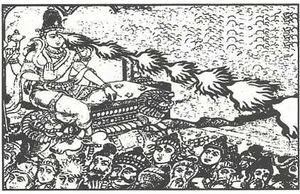Rudra
From Hindupedia, the Hindu Encyclopedia
By Swami Harshananda
Rudra literally means ‘the terrible’.
Rudra is a Vedic deity. He has been eulogized in only three suktas of the Ṛgveda out of which two are more explicit.[1] His name appears 75 times. He is also called ‘Śiva’ 18 times.
Definition of Rudra[edit]
The various definitions of the word Rudra are:
- One who roars or thunders
- One who makes his enemies weep
- One who destroys the sansāra[2] of his devotees
- One who destroys ajñāna or nescience
Form of Rudra[edit]
Rudra’s beauteous form has been described in various mantras. It can be briefed as belows:
- He is strong with powerful arms.
- He has a long jaṭā or hair.
- He is very handsome.
- His body is decorated with many ornaments of gold, especially a matchless necklace, is brilliant.
- He is holding a vajrāyudha,[3] a strong bow and arrows.
- When necessary he can also assume a fierce form.
- Riding on a chariot, he charges at our enemies if pray to him.
- Rudra is also full of mercy and a great protector of his votaries.
- Being closely associated with forests and mountains, he is also the king of medicines and hence a healer of all diseases.
- When supplicated, he destroys sins and grants happiness.
Works on Rudra[edit]
- The Rudrapraśna of the Taittiriya Samhitā[4] gives a long and beautiful description of Rudra.
- The Svetāśvatara Upaniṣad[5] describes him as the creator and ruler of the universe.
- The Mahābhārata[6] and also quite a few purāṇas declare Rudra as the form of Siva who destroys the universe at the end of a cycle of creation.
- In Vedic literature, sometimes eleven Rudras are mentioned. They may be minor deities representing the ten prāṇas[7] and the mind.
- In later literature,[8] eight names of Rudra are mentioned, which are actually the eight aspects of Rudra-Śiva.
- The eight Rudras or eleven Rudras, when considered as aspects of Rudra-Śiva, are described in detail along with their garments and weapons in iconographical works like Rupamandana and Viśvakarmaśilpa.
Spouses of Rudras[edit]
All the Rudras have their female counterparts or consorts like:
Band of Rudras[edit]
Rudra is also regarded as having created:
- Bhutas - demons
- Pretas - disembodied spirits
- Piśācakas - goblins
- Kuṣmāṇdas - malignant imps
References[edit]
- The Concise Encyclopedia of Hinduism, Swami Harshananda, Ram Krishna Math, Bangalore

